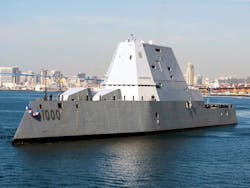Navy asks Raytheon to upgrade computers and networking shipboard electronics aboard Zumwalt-class destroyers
WASHINGTON – U.S. Navy shipboard electronics experts are asking RTX Corp. to upgrade computers and computer networking equipment aboard the Navy's three Zumwalt-class (DDG 1000) land-attack destroyers under terms of a $38.5 million order announced on 7 June.
Officials of the Naval Sea Systems Command in Washington are asking the RTX Raytheon segment in Tewksbury, Mass., for a technical refresh of DDG-1000-class Total Ship Computing Environment Hardware related to the Zumwalt Test Facility Ship Mission Center, peripherals, and spare parts.
The three Zumwalt-class destroyers are multi-mission stealth ships with onboard computers and computer networking that focus on land attack, with secondary roles of surface warfare, anti-aircraft warfare, and naval gunfire support.
The label destroyer is somewhat of a misnomer because the Zumwalt-class surface warships are about the size of small World War II battleships.
Navy officials separately have reached out to industry to find companies able to help integrate future hypersonic weapons aboard the Zumwalt-class destroyers: the USS Zumwalt (DDG 1000), the USS Michael Monsoor (DDG 1001), and the USS Lyndon B. Johnson (DDG 1002).
Installing hypersonic weapons aboard these three vessels is to be part of the Navy's Conventional Prompt Strike project to launch attacks against targets around the world in less than an hour. The focus is on attacking high-value, or fleeting targets, with extremely fast hypersonic weapons, which can fly faster than five times the speed of sound.
The Zumwalt-class destroyers have integrated electric propulsion (IEP) systems that can send electricity from turbo-generators to the electric drive motors or weapons, the Total Ship Computing Environment Infrastructure (TSCEI), automated fire-fighting systems, and automated piping rupture isolation. The class is designed to require a smaller crew and to be less expensive to operate than comparable warships.
The Navy Conventional Prompt Strike Weapon System Platform-Specific Development and Production project focuses on systems system architecture; subsystem, component, and test requirements; design analysis, and design integration; system integration, verification, and validation testing to support initial operating capability.
On this contract Raytheon will do the work in Manchester and Nashua, N.H.; Portsmouth, R.I.; and San Diego, and expected should be finished by May 2027. For more information contact RTX Raytheon online at www.rtx.com/raytheon, or Naval Sea Systems Command at www.navsea.navy.mil.
About the Author
John Keller
Editor-in-Chief
John Keller is the Editor-in-Chief, Military & Aerospace Electronics Magazine--provides extensive coverage and analysis of enabling electronics and optoelectronic technologies in military, space and commercial aviation applications. John has been a member of the Military & Aerospace Electronics staff since 1989 and chief editor since 1995.
